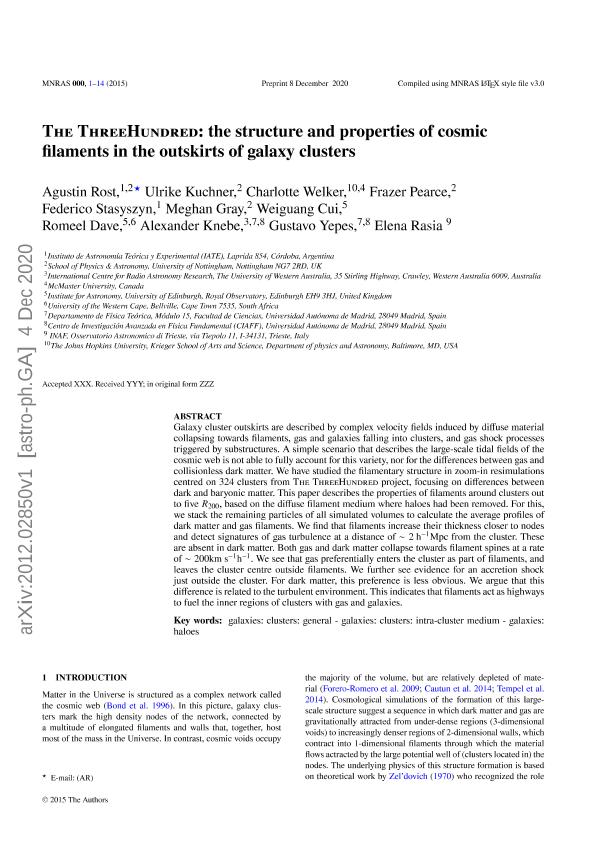Mostrar el registro sencillo del ítem
dc.contributor.author
Rost, Agustín Matías

dc.contributor.author
Kuchner, Ulrike
dc.contributor.author
Welker, Charlotte
dc.contributor.author
Pearce, Frazer
dc.contributor.author
Stasyszyn, Federico Andres

dc.contributor.author
Gray, Meghan
dc.contributor.author
Cui, Weiguang
dc.contributor.author
Dave, Romeel
dc.contributor.author
Knebe, Alexander
dc.contributor.author
Yepes, Gustavo
dc.contributor.author
Rasia, Elena
dc.date.available
2022-09-26T11:35:53Z
dc.date.issued
2021-03
dc.identifier.citation
Rost, Agustín Matías; Kuchner, Ulrike; Welker, Charlotte; Pearce, Frazer; Stasyszyn, Federico Andres; et al.; The threehundred: The structure and properties of cosmic filaments in the outskirts of galaxy clusters; Oxford Univ Press Inc; Monthly Notices of the Royal Astronomical Society; 502; 1; 3-2021; 714-727
dc.identifier.issn
0035-8711
dc.identifier.uri
http://hdl.handle.net/11336/170346
dc.description.abstract
Galaxy cluster outskirts are described by complex velocity fields induced by diffuse material collapsing towards filaments, gas, and galaxies falling into clusters, and gas shock processes triggered by substructures. A simple scenario that describes the large-scale tidal fields of the cosmic web is not able to fully account for this variety, nor for the differences between gas and collisionless dark matter. We have studied the filamentary structure in zoom-in resimulations centred on 324 clusters from the threehundred project, focusing on differences between dark and baryonic matter. This paper describes the properties of filaments around clusters out to five R200, based on the diffuse filament medium where haloes had been removed. For this, we stack the remaining particles of all simulated volumes to calculate the average profiles of dark matter and gas filaments. We find that filaments increase their thickness closer to nodes and detect signatures of gas turbulence at a distance of ∼2 h-1, Mpc from the cluster. These are absent in dark matter. Both gas and dark matter collapse towards filament spines at a rate of ∼200 km s-1 h-1. We see that gas preferentially enters the cluster as part of filaments, and leaves the cluster centre outside filaments. We further see evidence for an accretion shock just outside the cluster. For dark matter, this preference is less obvious. We argue that this difference is related to the turbulent environment. This indicates that filaments act as highways to fuel the inner regions of clusters with gas and galaxies.
dc.format
application/pdf
dc.language.iso
eng
dc.publisher
Oxford Univ Press Inc

dc.rights
info:eu-repo/semantics/openAccess
dc.rights.uri
https://creativecommons.org/licenses/by-nc-sa/2.5/ar/
dc.subject
GALAXIES: CLUSTERS: GENERAL
dc.subject
GALAXIES: CLUSTERS: INTRACLUSTER MEDIUM
dc.subject
GALAXIES: HALOES
dc.subject.classification
Astronomía

dc.subject.classification
Ciencias Físicas

dc.subject.classification
CIENCIAS NATURALES Y EXACTAS

dc.title
The threehundred: The structure and properties of cosmic filaments in the outskirts of galaxy clusters
dc.type
info:eu-repo/semantics/article
dc.type
info:ar-repo/semantics/artículo
dc.type
info:eu-repo/semantics/publishedVersion
dc.date.updated
2022-09-21T13:54:26Z
dc.identifier.eissn
1365-2966
dc.journal.volume
502
dc.journal.number
1
dc.journal.pagination
714-727
dc.journal.pais
Reino Unido

dc.journal.ciudad
Oxford
dc.description.fil
Fil: Rost, Agustín Matías. Consejo Nacional de Investigaciones Científicas y Técnicas. Centro Científico Tecnológico Conicet - Córdoba. Instituto de Astronomía Teórica y Experimental. Universidad Nacional de Córdoba. Observatorio Astronómico de Córdoba. Instituto de Astronomía Teórica y Experimental; Argentina. University of Nottingham; Estados Unidos
dc.description.fil
Fil: Kuchner, Ulrike. The University Of Nottingham. School Of Physics & Astronomy; Reino Unido
dc.description.fil
Fil: Welker, Charlotte. Mc Master University; Canadá. University Johns Hopkins; Estados Unidos
dc.description.fil
Fil: Pearce, Frazer. The University Of Nottingham. School Of Physics & Astronomy; Reino Unido
dc.description.fil
Fil: Stasyszyn, Federico Andres. Consejo Nacional de Investigaciones Científicas y Técnicas. Centro Científico Tecnológico Conicet - Córdoba. Instituto de Astronomía Teórica y Experimental. Universidad Nacional de Córdoba. Observatorio Astronómico de Córdoba. Instituto de Astronomía Teórica y Experimental; Argentina
dc.description.fil
Fil: Gray, Meghan. The University Of Nottingham. School Of Physics & Astronomy; Reino Unido
dc.description.fil
Fil: Cui, Weiguang. University of Edinburgh; Reino Unido
dc.description.fil
Fil: Dave, Romeel. University of Edinburgh; Reino Unido. University of Western Cape; Reino Unido
dc.description.fil
Fil: Knebe, Alexander. Universidad Autónoma de Madrid. Facultad de Ciencias; España. Centro de Investigación Avanzada en Física Fundamental; España
dc.description.fil
Fil: Yepes, Gustavo. Universidad Autónoma de Madrid. Facultad de Ciencias; España. Centro de Investigación Avanzada en Física Fundamental; España
dc.description.fil
Fil: Rasia, Elena. University Johns Hopkins; Estados Unidos. Osservatorio Astronomico di Trieste; Italia
dc.journal.title
Monthly Notices of the Royal Astronomical Society

dc.relation.alternativeid
info:eu-repo/semantics/altIdentifier/url/https://academic.oup.com/mnras/article/502/1/714/6031331
dc.relation.alternativeid
info:eu-repo/semantics/altIdentifier/doi/http://dx.doi.org/10.1093/mnras/staa3792
Archivos asociados
